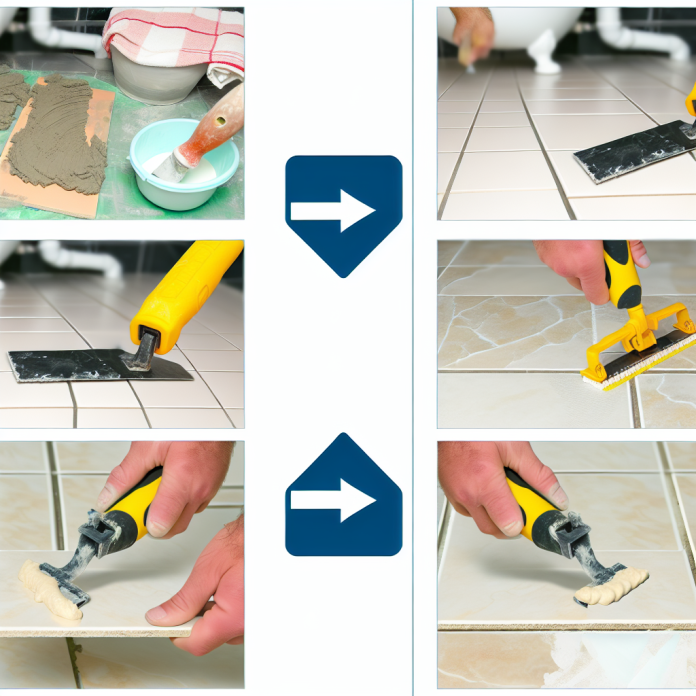Regrouting tiles is a fantastic way to revitalize your tile surfaces without the need for a full replacement. Over time, the grout between tiles can become damaged or discolored, affecting the overall aesthetic of your bathroom or kitchen. If you’re wondering how to regrout effectively, you’re in the right place! This article will guide you through the regrouting tile process step-by-step while also introducing you to the best grout for tiles suited for your project. With the right tools for regrouting and some DIY tile regrouting skills, you can achieve a fresh and clean look that enhances your space.
Transforming your tiled surfaces starts with understanding the importance of grout restoration. This crucial maintenance task, often overlooked, involves renewing the grout lines that bind your tiles, ultimately enhancing their appearance and longevity. Whether you’re dealing with faded, cracked, or simply outdated grout, regrouting can breathe new life into your floors and walls. Embracing this DIY project can not only save you money compared to a complete overhaul but also offers a rewarding sense of accomplishment. In this guide, we’ll explore the step-by-step process and essential tools needed for successful tile rejuvenation.
Understanding the Importance of Regrouting Tiles
Regrouting tiles is an essential home maintenance task that can drastically enhance both the appearance and durability of your tiled surfaces. Over time, grout can become discolored, damaged, or even harbor mold, compromising not only the aesthetic appeal but also the structural integrity of the tiles themselves. By regrouting, you’re not just restoring the look of your floors or walls; you’re also prolonging the lifespan of the tiles, preventing water damage, and reinforcing protection against dirt and bacteria.
In addition to improving looks, regrouting can be an economical choice compared to a complete tile replacement. The costs associated with new tiles—removal of old tiles, purchasing new ones, and installation—can add up quickly. On the other hand, with a little effort and some basic tools, it’s possible to save money while achieving a refreshed, clean appearance through effective DIY regrouting.
Frequently Asked Questions
What is the best grout for tiles when regrouting?
The best grout for tiles depends on the joint size. For joints of ¼ inch or less, use unsanded grout; for joints ½ inch or wider, opt for sanded grout. Always read the product label for specific recommendations.
How to regrout tiles effectively?
To regrout tiles effectively, start by removing old grout, cleaning the tile surface, mixing new grout correctly, and then filling the grout lines carefully. Finish by sealing the joints to protect against moisture.
What tools are needed for regrouting tiles?
Essential tools for regrouting tiles include an oscillating tool, trowel, grout float, cloth, sponge, and a bucket. Having a grout mix, sealant, and a tile finishing tool will also help ensure a successful regrouting process.
How long does the regrouting tile process take from start to finish?
The regrouting tile process can take a few hours to complete, but grout needs to set for 24 hours after application. Ensure to allow sufficient drying time before using the tiles.
Can I regrout tiles myself as a DIY project?
Yes, regrouting tiles can be a manageable DIY project. With the right tools and materials, anyone can follow the steps to safely and effectively regrout their tile floors.
Is it necessary to use a sealer when regrouting tiles?
Yes, sealing the grout after regrouting tiles is essential to protect against moisture and mold. A good sealer prolongs the life of the grout.
How can I remove old grout before regrouting tiles?
To remove old grout, use an oscillating tool or a grout saw to carefully extract the grout from between the tiles. Be patient and take care not to damage the tiles during removal.
| Key Points | Details |
|---|---|
| Why Regrout Tiles? | Transform tired and worn tiles without replacing the entire floor. |
| Tools Needed | Grout mix, tile sealant, oscillating tool, cloth, tape, bucket, trowel, knife, cleaner, toothbrush, sponge, grout float, tile finishing tool. |
| Time Required | A few minutes per tile for grouting; grout sets in 24 hours. |
| Steps to Regrout | 1. Prepare the grout area. 2. Remove old grout. 3. Vacuum the surface. 4. Mix grout. 5. Fill grout lines. 6. Clean with a sponge. 7. Seal joints with caulk. 8. Seal the grout. |
| Maintenance Tips | Regrouting helps maintain moisture resistance and prevents mold growth. |
Summary
Regrouting tiles is an essential home improvement task that can dramatically enhance the appearance of your tile flooring. By following the outlined steps and using the right tools, you can revitalize your tile floor without the need to replace it entirely. Whether you’re looking to refresh an outdated look or simply extend the life of your tiles, regrouting is a cost-effective solution. This DIY process not only improves aesthetics but also protects your tiles from moisture and mold, ensuring that they last for years to come.
Source: https://homeyimprovements.com/regrout-tile-simple-steps/
### Transform Your Home with Premier Orange County Remodeling Services
Are you a homeowner in Orange County looking to elevate your living space? Whether you reside in the scenic coastal town of Laguna Beach or the bustling city of Irvine, the OC remodeling market caters to a variety of styles and preferences. With a median home value soaring at $1.18 million, many homeowners are choosing to invest in high-value renovations ranging from $50,000 to over $500,000. This trend not only enhances their property but also aligns with California’s stringent building codes and climate considerations, ensuring that your dream home remains both aesthetically pleasing and functionally sound.
### Understanding the OC Market: Costs and Opportunities
In the competitive world of Orange County renovations, understanding the local market is key. Contractors servicing cities like Newport Beach and Costa Mesa can expect a diverse clientele of affluent homeowners eager to invest in meaningful upgrades. However, it’s essential to factor in local costs and regulations when planning any remodel. For example, obtaining the necessary permits and adhering to California building codes can influence project timelines and budgets. To remain competitive, OC contractors should be ready to provide clients with detailed estimates that include these elements, as well as showcasing a thorough knowledge of local suppliers who can provide high-quality materials suited to the coastal climate.
### Local Insights for Effective Remodeling
For contractors working in the picturesque settings of Huntington Beach or the vibrant city of Costa Mesa, it’s vital to tailor your services to the unique characteristics of each area. Emphasizing energy-efficient solutions can be appealing to homeowners looking to reduce utility costs while placing a premium on sustainability. Furthermore, as a contractor, promoting your experience with the local approvals process can set you apart in the market. You might also highlight successful past projects that resonate with your target audience, showcasing a deep understanding of OC-specific trends and aesthetics.
### Engage with Homeowners and Elevate Your Services
As a home service professional, building a rapport with local homeowners is crucial. Leverage social media platforms to showcase before-and-after images of OC remodeling projects, alongside client testimonials that highlight your expertise and dedication. Moreover, consider hosting local workshops or webinars that educate homeowners on home improvement trends specific to Orange County—covering topics like maximizing ocean views in Laguna Beach or achieving modern designs in Irvine. These engagement opportunities not only boost your visibility as an authority in the field but also create a welcoming atmosphere for potential clients.
### Conclusion: Drive Your Remodeling Business Forward
In the rich landscape of Orange County remodeling, understanding the local context can significantly impact your business. As you navigate the diverse markets of Laguna Beach to Irvine, remember to keep abreast of California regulations, leverage local suppliers, and cultivate relationships with homeowners. By doing so, you can not only transform spaces but also build a thriving remodeling business that is well-respected in the OC community. Ready to elevate your contracting game? Start engaging with your local network today!


